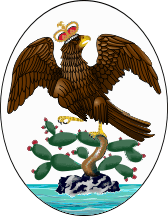
|
Mexican Shield/Coat-of-Arms 1821-1823
In 1821, Don Agustín de Iturbide, as president of the provisional government decreed that the National Flag should contain vertical stripes in colors green, white and red, adding to the white center a crowned eagle, resting on the legendary nopal.
Late in 1821, Agustín de Iturbide, was proclaimed emperor first by the people and then by the Supreme Congress, officially as a temporary measure until a member of European royalty could be persuaded to become monarch of Mexico. In 1823, a revolt against Iturbide established the United Mexican States.
While Agustín was emperor this shield was used on the national flag until in 1823 when he was deposed.
|
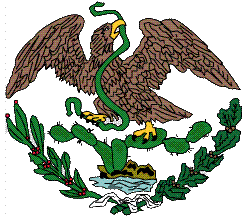
|
Mexican Shield/Coat-of-Arms 1823-1864
Readopted 1867-1881
In 1823, when Iturbide fell, the Supreme Congress decreed that the crown worn by the eagle was to be removed, and adding a half circle of green oak (encino) and laurel branches. These elements have lasted until today, although the eagle has changed from profile to three-quarters view. This was used from 1823-1864 during the establishment of the Mexican Republic.
It was readopted from 1867-1881 when the Mexican Republic was reestablished after Maximilian's reign.
|

|
Mexican Shield/Coat-of-Arms 1864-1881
Used from 1864-1867 during the Second Mexican Empire of Maximilian I. This empire was established after a joint British, Spanish, and French occupational force temporarily invaded Mexico to force payment of Mexican debits. The British and Spanish forces soon left, but the French forces stayed on to support the reign of Maximilian.
The Habsburg Archduke Ferdinand Maximilian of Austria and his wife Belgian wife Carlota, a cousin of Queen Victoria of the United Kingdom, were placed on the throne of Mexico as Emperor Maximilian I and the Empress Carlota of Mexico. They ruled with support of the French occupational forces, the Roman Catholic clergy, conservative elements of the upper class, and some indigenous communities. Although the French, then considered one of the most efficient armies of the world, suffered an initial defeat in the Battle of Puebla in 1862 (now commemorated as the Cinco de Mayo holiday), they eventually defeated the Mexican government forces led by General Ignacio Zaragoza and set the couple upon the throne.
In 1863, Maximiliano de Habsburgo, now the second Emperor of Mexico, reintroduced the royal crown, and the coat of arms was surrounded by the Imperial mantle with the motto "Religion, Independence" (Religión, Independencia). In 1865, in a second version for Maximiliano, the royal crown disappeared and two glyphs were introduced with the motto "Equity in Justice" (Equidad en la Justicia).
|
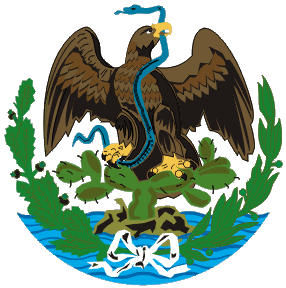
|
Mexican Shield/Coat-of-Arms 1881-1899
Maximilian was eventually overthrown and executed by the forces loyal to President Benito Juárez, who kept the federal government functioning during the French intervention that put Maximilian in power. In 1867, the republic was restored and Juárez was reelected, continuing to implement his reforms. In 1871 he was elected a second time, much to the dismay of his opponents within the liberal party, who considered reelection to be something undemocratic. Juárez died one year later and was succeeded by Sebastián Lerdo de Tejada.
In the election of 1876, Lerdo was re-elected, defeating his opponent Porfirio Díaz. After the election, Díaz rebelled against the government and managed to overthrow Lerdo, who fled the country. Díaz became the new president. Thus began a period of more than thirty years (1876-1911) during which Díaz was the strong man in Mexico.
In 1880, President Porfirio Díaz decided that the eagle should display wings, following the French trend, and no crown. This design was adopted by decree on December 20, 1880, and used a design by Tomás de la Peãta, a well-known and popular Mexican painter of this time period.
|
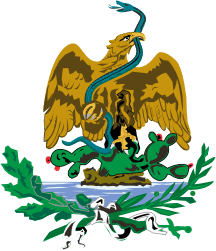
|
Mexican Shield/Coat-of-Arms 1899-1917
Called the Eagle of the Centennial, Porfirio Díaz attempted by a decree to unify the National Coat of Arms in 1899, he adopted this emblem, designed by Mexican sculptor Juan de Dios Ferníndez.
During this period of Porfirio Díaz poorly disguised dictatorship, the country's infrastructure improved greatly thanks to increased foreign investment, but the period is also characterized by social inequality and discontent among the working classes. In 1910, the 80-year-old Díaz decided to hold an election to serve another term as president. When the official election results were announced, it was declared that Díaz had won re-election almost unanimously, with his opponent receiving only a few hundred votes in the entire country. This fraud by Díaz was too blatant for the public to swallow, and riots broke out starting the Mexican Revolution.
The Federal Army was defeated by the revolutionary forces which were led by, amongst others, Emiliano Zapata in the South, Pancho Villa and Pascual Orozco in the North, and Venustiano Carranza as Chief of the Constitutionalist Army. Porfirio Díaz resigned in 1911 for the "sake of the peace of the nation" and went to exile in France, where he died in 1915.
This Coat of Arms, was used until 1916, when Venustiano Carranza decided to re-adopt and use the older type of national coat-of-arms on his flags.
|
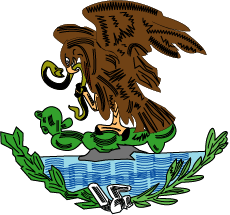
|
Mexican Shield/Coat-of-Arms 1916-1918
This is the shield for the national flag that was adopted by Venustiano Carranza, who in 1816 was the Chief of the Constitutionalist Army. It was first flown in 1917.
Venustiano Carranza was Senator for his native State during Porfirio Díaz's dictatorship. Through the proclamation of the Plan of Guadalupe in 1913, Carranza proclaimed himself as Chief of the Constitutionalist Army, as an effort to restore order to the boiling country. After several victorious battles, Carranza and his army entered Mexico City on August 20, 1914. In 1917, the Constitución Política de los Estados Unidos Mexicanos (Political Constitution of the Mexican United States), was proclaimed and still remains in effect today.
In 1920, Carranza was elected the second President of Mexico under the new constitution.
|
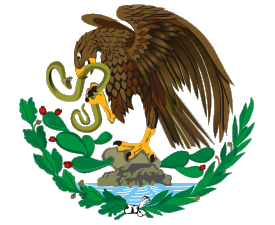
|
Mexican Shield 1918-1934
It seems the 1916 version of the shield did not completely satisfy Venustiano Carranza, who ordered a new design in 1918.
The new design had the same elements of the traditional Mexican Coat of Arms: eagle, snake, nopal, stone, garland and ribbon, but the eagle is bending over, showing its left profile, had its head bowed with the wings expanded down, and the tail expanded and higher than its predecessor. The nopal was made up with nine leaves, thus adding three more than the former one. This design was created by the artists Antonio Gómez and Jorge Enciso.
|
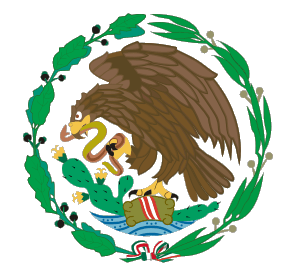
|
Mexican Shield 1934-1968
In 1934, the flag and coat-of-arms models were once again re-designed, this time with an updated design by Jorge Enciso.
In 1918, President Venustiano Carranza had reversed the changes made by Díaz, and restored some of the original Aztec symbols. In this version the water snake was replaced with a rattlesnake, and the eagle was seen in a side view instead of a front view.
However, due to the political problems of the time, this new retro-design was not made official until 1934, under President Abelardo L. Rodríguez
|
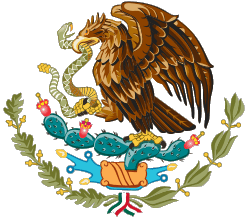
|
Mexican Shield/Coat-of-Arms 1968 to present
In 1968, President Gustavo Díaz Ordaz ordered another small change, he wanted the eagle to look more aggressive. This design, by the painter Francisco Eppens Helguera, is still used today. Also, at the same time a law was made to define and control the use of the national symbols.
This is now the present version of the Mexican Shield and Coat-of-Arms and is used on the national flag on land as the civil, state and war flag, and at sea as the naval ensign.
note: There is also a "unofficial" version of this shield done all in gold, and it is sometimes displayed on national flags.
|
- My thanks to Juan Manuel Gabino Villascán for all his expert help and advice on this page -
| Top of Page | Return to Mexican Flags Page | Return to "Vexillological Essays and Chart Pages Menu" |